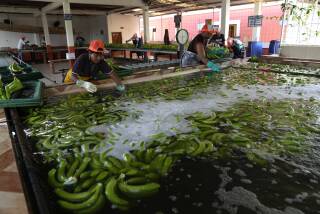U.S. Report Cites ‘Gains’ in War on Cocaine, Plays Down Setbacks
- Share via
WASHINGTON — “Important gains” have been made in cutting back coca planting and seizing cocaine, the State Department emphasized in its annual drug control report released Saturday, while playing down setbacks in the fight against narcotics.
“We can’t respond to what will be inevitable setbacks or blips in our record of progress by ripping apart the strategy and starting all over again,” said Melvyn Levitsky, assistant secretary of state for international narcotics.
“Victory in the drug war is still a long way away,” said Levitsky, who will testify before Congress seven times in the next two weeks on the report, which has become a measure of international performance in stemming illicit narcotics.
Acting on the country-by-country assessment, President Bush on Friday denied certification for full U.S. aid to four nations for their lack of action or cooperation in the drug war--Afghanistan, Myanmar (formerly Burma), Iran and Syria. He gave a “national interests” waiver to Lebanon, which a State Department official noted lacks control over the Syrian-occupied Bekaa Valley, Lebanon’s chief drug-producing area.
The same four nations were denied certification last year, and the action has largely symbolic value because none receives U.S. aid, although the denial also means that the United States will vote against multilateral development bank loans to the four. However, Congress can also deny certification, and that opportunity is expected to prompt scrutiny of such now-certified countries as Peru, source of the raw material for about 60% of the cocaine that is produced.
Bush did certify 22 drug-producing or -transiting nations for aid, including Venezuela and China, which were added to the list this year.
The conflicting nature of the report’s statistics was apparent in the measure of the planting and potential yield of coca--the crop from which cocaine is refined.
In 1991 for the second consecutive year, the report said, coca under cultivation declined--from 211,800 hectares in 1990 to 206,000. (A hectare is equal to 2.47 acres.) But after deducting local consumption and local seizures, the 1991 cocaine production potentially reached a new record of between 995 and 1,170 metric tons of finished product.
These figures reflect the amount of cocaine that could be made from the processing of all of the coca leaves. But the totals do not take into account losses from “inefficiencies, bad weather, disease or the deterrent effects of law enforcement,” according to the report, and thus do not represent what is actually available. “That amount remains unknown.”
The seeming contradiction--reduction of area under cultivation, but higher potential production--partly results from a coca plant taking three years to mature and produce a leaf for processing into cocaine. Thus, 1991 production reflects plants under cultivation in 1988--the year before a peak of 222,000 hectares, federal drug officials said.
“Since 1989 was the last year of major coca expansion, we expect to see a leveling off in leaf production next year, assuming that hectarage (the area planted) does not increase,” the report said.
The State Department described the record of cocaine seizure as “particularly impressive,” estimating that the figure “could well reach 300 metric tons” for 1991.
On the negative side, the report cited less successful efforts to reduce the flow of opium and heroin. Most opium poppies--the crop from which both drugs are produced--are grown in Myanmar, Afghanistan and Iran, where the United States and other anti-narcotics governments have little or no influence.
The State Department said that an indication that some traffickers “view heroin as the drug of the future is the further spread of opium cultivation into the Western Hemisphere.”
Levitsky pointed out that the United States consumes probably 70% of the cocaine and 10% of heroin and opium used worldwide.
More to Read
Sign up for Essential California
The most important California stories and recommendations in your inbox every morning.
You may occasionally receive promotional content from the Los Angeles Times.













